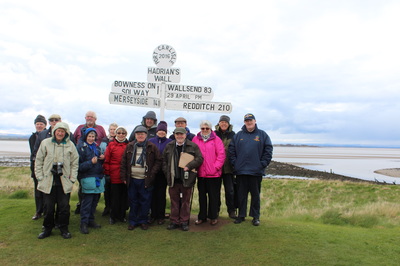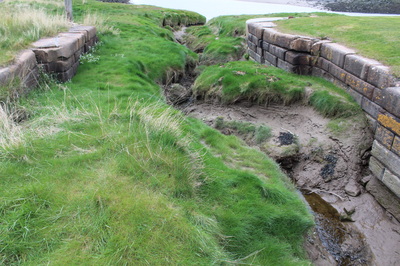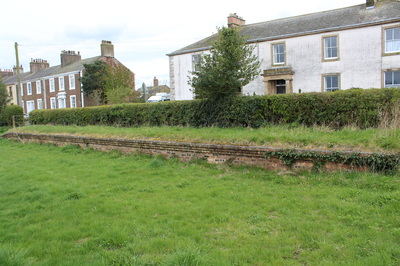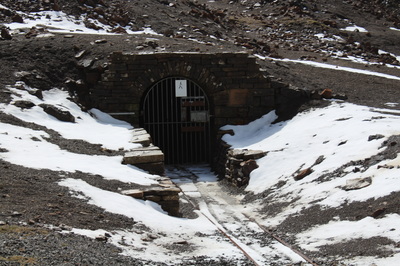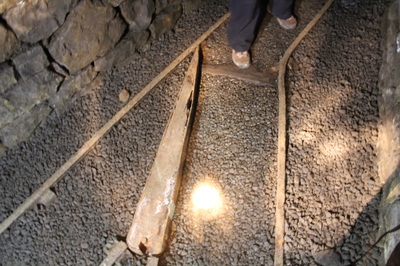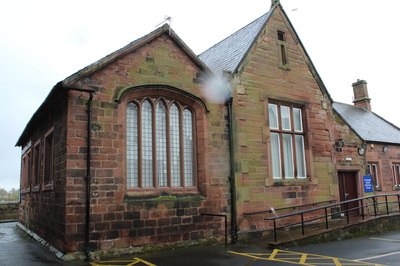LONG WEEKEND 29th APRIL 2nd MAY 2016
CUMBRIA & THE LAKE DISTRICT
CUMBRIA & THE LAKE DISTRICT
FRIDAY 29th April 2016
Thirteen of us met at Lime Street Station with two more in Malcolm's car (along with a load of luggage) whilst 3 others were making their way up independently. Malcolm Brett drove up the M6 to Tebay in pretty foul weather and, after a break there, Peter Purland took over the wheel for the drive via Cockermouth to Maryport.
At Maryport we had just over an hour's break to look around and have lunch. A chip shop was well patronised and so was the Maritime Museum. Maryport was established at least as early as Roman times and had a Medieval Castle but the modern town was founded by Humphrey Senhouse after 1749. It developed ironworks, there were a lot of coal mines in the area shipbuilding developed (many ships being launched sideways) the docks were extended by first the Senhouse Dock and then the Elizabeth Dock and it grew to be the biggest port in Cumbria. However the iron works moved to Workington, coal exporting declined and the opening of the new dock in Workington in 1927 all but killed Maryport. Unemployment stood at 57%. There was a short lived boom during WWII but by the 1960s the commercial port had closed.
We then moved on to Silloth, still the second busiest port in Cumbria, and also a good example of a fairly genteel Victorian Seaside Resort. It developed with the coming of the railway in the 1850s and reached its peak at the turn of the 19th\20th centuries. It has seen some improvements in recent years and remains a very pleasant town. From here we drove up the coast, viewing the remains of the Solway Viaduct and arrived in Port Carlisle. Although on the line of Hadrian's Wall, there was no settlement here until the construction of the canal.
The port was built in 1819 and four years lthe canal was completed to take goods to Carlisle Basin. The canal was closed in 1853 and Port Carlisle silted up. You can still see the remains of the passenger pier and the coal unloading wharf. The canal basin at Carlisle and parts of the canal were filled in by the Port Carlisle Railway Company and a passenger service was provided in 1854. This stopped when the Silloth line opened in 1856 but a horse-drawn service was provided in 1856 between Drumburgh and Port Carlisle known as the "Dandy". In 1914 steam took over but only lasted until 1932 when the line closed.
Today you can still see some remains of both canal and railway and we were shown round these by Reg and his wife. These included the sea lock, basin and old platform at Port Carlisle Station. We had a drink at the Methodist Chapel before heading off for our hotel. We settled in and after a good three course dinner had a talk on the industries of Northern Cumbria by Graham Brooks, chairman of the Cumbria IHS. He gave a comprehensive overview of the many and varied industries of the area, whetting our appetites for the next three days.
Hover on images for captions.
Thirteen of us met at Lime Street Station with two more in Malcolm's car (along with a load of luggage) whilst 3 others were making their way up independently. Malcolm Brett drove up the M6 to Tebay in pretty foul weather and, after a break there, Peter Purland took over the wheel for the drive via Cockermouth to Maryport.
At Maryport we had just over an hour's break to look around and have lunch. A chip shop was well patronised and so was the Maritime Museum. Maryport was established at least as early as Roman times and had a Medieval Castle but the modern town was founded by Humphrey Senhouse after 1749. It developed ironworks, there were a lot of coal mines in the area shipbuilding developed (many ships being launched sideways) the docks were extended by first the Senhouse Dock and then the Elizabeth Dock and it grew to be the biggest port in Cumbria. However the iron works moved to Workington, coal exporting declined and the opening of the new dock in Workington in 1927 all but killed Maryport. Unemployment stood at 57%. There was a short lived boom during WWII but by the 1960s the commercial port had closed.
We then moved on to Silloth, still the second busiest port in Cumbria, and also a good example of a fairly genteel Victorian Seaside Resort. It developed with the coming of the railway in the 1850s and reached its peak at the turn of the 19th\20th centuries. It has seen some improvements in recent years and remains a very pleasant town. From here we drove up the coast, viewing the remains of the Solway Viaduct and arrived in Port Carlisle. Although on the line of Hadrian's Wall, there was no settlement here until the construction of the canal.
The port was built in 1819 and four years lthe canal was completed to take goods to Carlisle Basin. The canal was closed in 1853 and Port Carlisle silted up. You can still see the remains of the passenger pier and the coal unloading wharf. The canal basin at Carlisle and parts of the canal were filled in by the Port Carlisle Railway Company and a passenger service was provided in 1854. This stopped when the Silloth line opened in 1856 but a horse-drawn service was provided in 1856 between Drumburgh and Port Carlisle known as the "Dandy". In 1914 steam took over but only lasted until 1932 when the line closed.
Today you can still see some remains of both canal and railway and we were shown round these by Reg and his wife. These included the sea lock, basin and old platform at Port Carlisle Station. We had a drink at the Methodist Chapel before heading off for our hotel. We settled in and after a good three course dinner had a talk on the industries of Northern Cumbria by Graham Brooks, chairman of the Cumbria IHS. He gave a comprehensive overview of the many and varied industries of the area, whetting our appetites for the next three days.
Hover on images for captions.
SATURDAY 30th APRIL
We left the hotel promptly at 09:00 and headed for Nenthead. A skew bridge on the former Alston branch brought us to a juddering halt. No we did not hit it but most of the bus wanted to photograph it. (see above). We then proceeded to Nenthead where we had a private tour of part of the mine. Mining has gone on small scale since the 17c but in 1745 the London Lead Company took over the workings and controlled them until 1882. They then went through a variety of owners until 1938 when mining stopped. Since the war the spoil heaps were worked for 20 years by companies looking for firstly zinc and lead and latterly fluorspar. We went in to the mine in two groups (your webmaster knocked a support down and, for a second, feared the worst but luck was on his side) and had a well lead tour looking at geology, working conditions and how minerals were won. We then had a quick look round the outside before lunch in the old barracks building.
Departing Nenthead we drove to Alston where most of the party got off in the Market Place and walked down to the station. The branch from Haltwhistle was opened in 1852 and, despite various plans to extend it, nothing happened and it soldiered on until 1st May 1976 when closure came. There were various preservation plans but in the end a narrow guage line commenced service in 1983.
It was extended to Gilderdale in 1987 and reached its present limit, Lintley in 2012. We had a round trip on the railway and then drove to Lambley Viaduct.
This was completed in 1852 and it is still possible to walk across it (which most of the party did. We eventually headed back to Carlisle and a 19:30 dinner. This was followed by a talk given by the Revd Alan Postlethwaite which was an entertaining account of his many and varied interests in industrial archaeology.
Hover on images for captions.
We left the hotel promptly at 09:00 and headed for Nenthead. A skew bridge on the former Alston branch brought us to a juddering halt. No we did not hit it but most of the bus wanted to photograph it. (see above). We then proceeded to Nenthead where we had a private tour of part of the mine. Mining has gone on small scale since the 17c but in 1745 the London Lead Company took over the workings and controlled them until 1882. They then went through a variety of owners until 1938 when mining stopped. Since the war the spoil heaps were worked for 20 years by companies looking for firstly zinc and lead and latterly fluorspar. We went in to the mine in two groups (your webmaster knocked a support down and, for a second, feared the worst but luck was on his side) and had a well lead tour looking at geology, working conditions and how minerals were won. We then had a quick look round the outside before lunch in the old barracks building.
Departing Nenthead we drove to Alston where most of the party got off in the Market Place and walked down to the station. The branch from Haltwhistle was opened in 1852 and, despite various plans to extend it, nothing happened and it soldiered on until 1st May 1976 when closure came. There were various preservation plans but in the end a narrow guage line commenced service in 1983.
It was extended to Gilderdale in 1987 and reached its present limit, Lintley in 2012. We had a round trip on the railway and then drove to Lambley Viaduct.
This was completed in 1852 and it is still possible to walk across it (which most of the party did. We eventually headed back to Carlisle and a 19:30 dinner. This was followed by a talk given by the Revd Alan Postlethwaite which was an entertaining account of his many and varied interests in industrial archaeology.
Hover on images for captions.
SUNDAY 1st MAY
Another prompt 09:00 start, but this time in poorer weather, saw us heading for Caldbeck. This is a very pretty little village and our first objective was Howk Bobbin Mill. We were met there by Warren Allison who was to be our guide for the morning. The mill was founded in 1857 in the Howk Valley and was powered by a 42 foot 3 inch diameter water wheel - the second biggest in the country. The mill eventually closed in 1924. We then had tea or coffee at the Watermill Cafe before visiting the church where we saw the grave of John Peel (although not that early in the morning!).
We then headed for Carrock Mine but had a brief stop at Carrock End Mine. The waterwheel (no longer there) was situated 300 yards from the shaft! The wind here was so strong that we struggled to stand. We then moved on to the remains of Carrock Mine. |Although originally a lead mine in 17c by the 20c this was the only mine north of Cornwall that worked wolfram. The last workings were in the early 1980s. We saw the adit and the remains of WWI buildings (and braved more foul weather) before adjourning to the Mill Inn in Mungrisdale for a sandwich and cake lunch.
We said goodbye to Warren who had been an excellent guide and made our way to Glenridding where we sailed the length of Lake Ullswater on the 127 year old former steamer, Raven. We also got a photo of the even older Lady of the Lake which dates from 1877. The weather had improved sufficiently for most of the party to sit out on deck.
The drivers returned by taxi to Glenriding then picked the rest of the party up from Pooley Bridge and were back at the hotel just after 17:30. After dinner at 19:00 we had Rob and John's traditional quiz before final packing ready for a full day on Monday.
Hover on images for captions.
Another prompt 09:00 start, but this time in poorer weather, saw us heading for Caldbeck. This is a very pretty little village and our first objective was Howk Bobbin Mill. We were met there by Warren Allison who was to be our guide for the morning. The mill was founded in 1857 in the Howk Valley and was powered by a 42 foot 3 inch diameter water wheel - the second biggest in the country. The mill eventually closed in 1924. We then had tea or coffee at the Watermill Cafe before visiting the church where we saw the grave of John Peel (although not that early in the morning!).
We then headed for Carrock Mine but had a brief stop at Carrock End Mine. The waterwheel (no longer there) was situated 300 yards from the shaft! The wind here was so strong that we struggled to stand. We then moved on to the remains of Carrock Mine. |Although originally a lead mine in 17c by the 20c this was the only mine north of Cornwall that worked wolfram. The last workings were in the early 1980s. We saw the adit and the remains of WWI buildings (and braved more foul weather) before adjourning to the Mill Inn in Mungrisdale for a sandwich and cake lunch.
We said goodbye to Warren who had been an excellent guide and made our way to Glenridding where we sailed the length of Lake Ullswater on the 127 year old former steamer, Raven. We also got a photo of the even older Lady of the Lake which dates from 1877. The weather had improved sufficiently for most of the party to sit out on deck.
The drivers returned by taxi to Glenriding then picked the rest of the party up from Pooley Bridge and were back at the hotel just after 17:30. After dinner at 19:00 we had Rob and John's traditional quiz before final packing ready for a full day on Monday.
Hover on images for captions.
MONDAY 2nd MAY
We departed on time and fully packed for the fourth day in a row. It has been a good effort by all participants. Sadly the weather was not as good and we met our guide and eminent local historian, Dennis Perriam, at the Market Cross in Carlisle. We admired the restoration work that has been done on most buildings there before following our guide round the streets of Carlisle. He was really knowledgeable and put things over very well, my only disappointment was that Carlisle City Council seem to have done a better demolition job in the city centre than the Luftwaffe did in Liverpool! Still we saw all that remained and even the sun came out at the end.
We then drove to Tebay Services where we had a meal and brought some fresh farm produce before continuing to Claughton near Lancaster where there is an aerial runway which is still rope "hauled". As it was Bank Holiday it was not working but we looked at it and, of course, took many photos. This was another very successful weekend and our thanks go to Malcolm and Renee Verity who yet again put together an excellent package.
If you are in the society and have not yet been on a trip I would really recommend it - I hope these images will encourage you. If you are not in the society and are interested in the above mentioned trip please join us. I would be happy to provide details. [email protected]
Hover on images for captions.
We departed on time and fully packed for the fourth day in a row. It has been a good effort by all participants. Sadly the weather was not as good and we met our guide and eminent local historian, Dennis Perriam, at the Market Cross in Carlisle. We admired the restoration work that has been done on most buildings there before following our guide round the streets of Carlisle. He was really knowledgeable and put things over very well, my only disappointment was that Carlisle City Council seem to have done a better demolition job in the city centre than the Luftwaffe did in Liverpool! Still we saw all that remained and even the sun came out at the end.
We then drove to Tebay Services where we had a meal and brought some fresh farm produce before continuing to Claughton near Lancaster where there is an aerial runway which is still rope "hauled". As it was Bank Holiday it was not working but we looked at it and, of course, took many photos. This was another very successful weekend and our thanks go to Malcolm and Renee Verity who yet again put together an excellent package.
If you are in the society and have not yet been on a trip I would really recommend it - I hope these images will encourage you. If you are not in the society and are interested in the above mentioned trip please join us. I would be happy to provide details. [email protected]
Hover on images for captions.







